Related Research Articles

A caboose is a crewed North American railroad car coupled at the end of a freight train. Cabooses provide shelter for crew at the end of a train, who were formerly required in switching and shunting, keeping a lookout for load shifting, damage to equipment and cargo, and overheating axles.
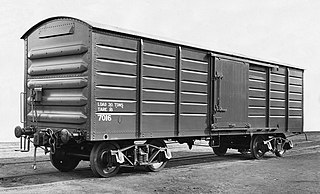
A boxcar is the North American (AAR) and South Australian Railways term for a railroad car that is enclosed and generally used to carry freight. The boxcar, while not the simplest freight car design, is considered one of the most versatile since it can carry most loads. Boxcars have side sliding doors of varying size and operation, and some include end doors and adjustable bulkheads to load very large items.

In railroad terminology, a stock car or cattle car is a type of rolling stock used for carrying livestock to market. A traditional stock car resembles a boxcar with louvered instead of solid car sides for the purpose of providing ventilation; stock cars can be single-level for large animals such as cattle or horses, or they can have two or three levels for smaller animals such as goats, sheep, pigs, and poultry. Specialized types of stock cars have been built to haul live fish and shellfish and circus animals such as camels and elephants. Until the 1880s, when the Mather Stock Car Company and others introduced "more humane" stock cars, death rates could be quite high as the animals were hauled over long distances. Improved technology and faster shipping times have greatly reduced deaths.
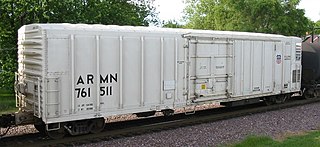
A refrigerator car is a refrigerated boxcar (U.S.), a piece of railroad rolling stock designed to carry perishable freight at specific temperatures. Refrigerator cars differ from simple insulated boxcars and ventilated boxcars, neither of which are fitted with cooling apparatus. Reefers can be ice-cooled, come equipped with any one of a variety of mechanical refrigeration systems, or use carbon dioxide or liquid nitrogen as a cooling agent. Milk cars may or may not include a cooling system, but are equipped with high-speed trucks and other modifications that allow them to travel with passenger trains.

An autorack, also known as an auto carrier, is a specialized piece of railroad rolling stock used to transport automobiles and light trucks. Autoracks are used to transport new vehicles from factories to automotive distributors, and to transport passengers' vehicles in car shuttles and motorail services, such as Amtrak's Auto Train route.

Alonzo Clark Mather was founder and president of the Mather Stock Car Company, a U.S. firm that built and leased railroad freight cars, especially stock cars.
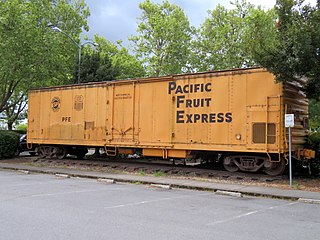
Pacific Fruit Express was an American railroad refrigerator car leasing company headquartered in San Francisco. At one point, it was the largest refrigerator car operator in the world.

The Central of Georgia Railway started as the Central Rail Road and Canal Company in 1833. As a way to better attract investment capital, the railroad changed its name to Central Rail Road and Banking Company of Georgia. This railroad was constructed to join the Macon and Western Railroad at Macon, Georgia, in the United States, and run to Savannah. This created a rail link from Chattanooga, on the Tennessee River, to seaports on the Atlantic Ocean. It took from 1837 to 1843 to build the railroad from Savannah to the eastern bank of the Ocmulgee River at Macon; a bridge into the city was not built until 1851.

The Akron, Canton and Youngstown Railroad was a Class I railroad which operated in the state of Ohio. The company was founded in 1907 and opened its mainline between Mogadore and Akron, Ohio in 1912. Later reclassified as a short-line railroad, the company was bought by the Norfolk and Western Railway in 1964 and merged in 1982. Despite the name, the company served neither Canton nor Youngstown.
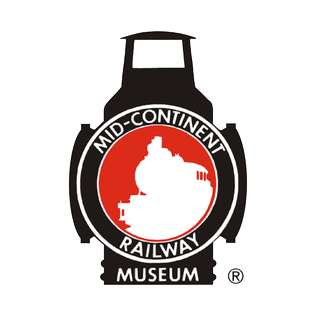
The Mid-Continent Railway Museum is a railroad museum in North Freedom, Wisconsin, United States. The museum consists of static displays as well as a 7-mile (11 km) round trip ride aboard preserved railroad cars.
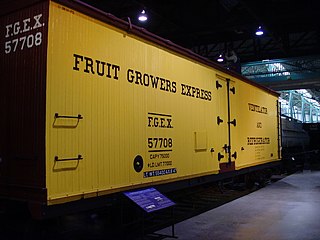
Fruit Growers Express (FGE) was a railroad refrigerator car leasing company that began as a produce-hauling subsidiary of Armour and Company's private refrigerator car line. Armour controlled both the packing operations and the transport insulated railroad car line, and its customers had complained they were overcharged. In 1919 the Federal Trade Commission ordered the company's spinoff of Fruit Growers Express for antitrust reasons, which was accomplished by 1920.
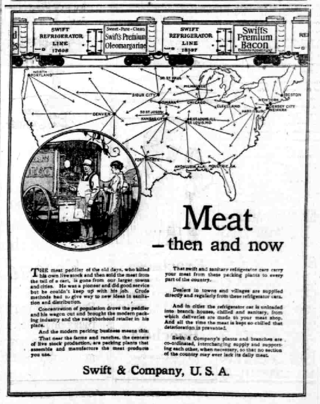
The Swift Refrigerator Line was a private refrigerator car line established around 1875 by Chicago meat packer Gustavus Swift, the founder of Swift and Company.

The Tidewater Southern Railway was a short line railroad in Central California in the United States. For most of its history, it was a subsidiary of the Western Pacific Railroad. It was originally built as an interurban system, connecting to the Central California Traction Company, Western Pacific Railroad, Southern Pacific Railroad and Atchison, Topeka and Santa Fe Railway in Stockton, California. Its mainline went southeast from Stockton to Escalon, California and thence to Modesto, California before splitting into two branches ending at the towns of Turlock and Hilmar. Until the mid-1930s, there were plans to extend the line to Fresno and even toward the Los Angeles area. Today, much of the line is still operated by the Union Pacific Railroad. Of all the former interurban railroads in California, the former Tidewater Southern retains the highest percentage of still operating trackage.
The North Western Refrigerator Line (NWX) was a Chicago, Illinois-based private refrigerator car line established in 1924, one of the last such companies to be formed. Between 1924 and 1940 the company acquired more than 3,000 new wood refrigerator cars originally built by the American Car and Foundry Company, and leased the former Ringling Brothers Circus railroad car plant in Baraboo, Wisconsin to serve as a car shop.
The Akron and Barberton Belt Railroad was a switching railroad that was built to serve various industries around the cities of Barberton and Akron in Ohio. It was formed through the consolidation of several formerly independent lines that totaled 22.96 miles (36.95 km), with a couple further acquisitions within a few years to extend the tracks to certain industries and to other interchange locations.

The Indiana Transportation Museum was a railroad museum that was formerly located in the Forest Park neighborhood of Noblesville, Indiana, United States. It owned a variety of preserved railroad equipment, some of which still operate today. ITM ceased operations in 2023.

The Museum of the American Railroad, formerly known as the Age of Steam Railroad Museum, is a railroad museum in Frisco, Texas. The museum has more than 70 pieces of steam, diesel, passenger, and freight railroad equipment sitting on 15 acres making it one of the largest historic rail collections in the US. Guests may walk through some of the equipment on guided tours.
The Youngstown and Ohio River Railroad, or Y&OR, was one of the smaller interurban railways in the state of Ohio. Along with the Youngstown and Southern Railway, the Y&OR formed a traction link between Youngstown, Ohio and the Ohio River at East Liverpool. It served several coal mines in the area and it was distinguished by the unusual feat of electrifying a section of a steam railroad, the Pittsburgh, Lisbon and Western Railroad, as part of a trackage rights agreement. The Y&OR operated for 24 years.
The Steam Railroading Institute is located at 405 South Washington Street, Owosso, Michigan. It was founded in 1969 as the Michigan State University (MSU) Railroad Club. It became the Michigan State Trust for Railway Preservation, and later adopted its present name.
Ensign Manufacturing Company, founded as Ensign Car Works in 1872, was a railroad car manufacturing company based in Huntington, West Virginia. In the 1880s and 1890s Ensign's production of wood freight cars made the company one of the three largest sawmill operators in Cabell County. In 1899, Ensign and twelve other companies were merged to form American Car and Foundry Company.
References
- Emporis (2004), Mather Tower, Chicago [usurped] . Retrieved March 23, 2005.
- Mid-Continent Railway Museum, Akron Canton & Youngstown #3011 . Retrieved March 24, 2005.
- Pacific Southwest Railway Museum Association (1992), Akron, Canton and Youngstown #3024 . Retrieved March 23, 2005
- Pacific Western Rail Systems (2003), Mather Meat Refrigerator Cars . Retrieved March 24, 2005.